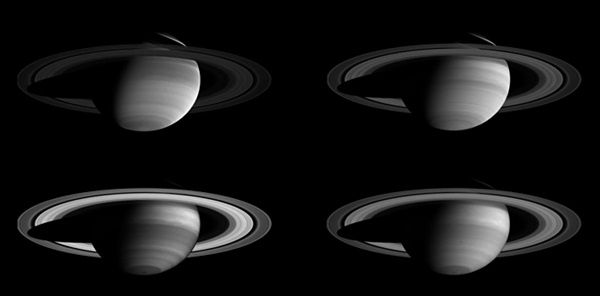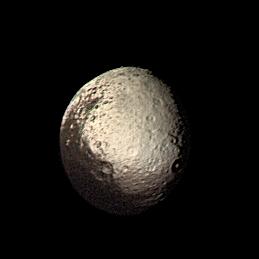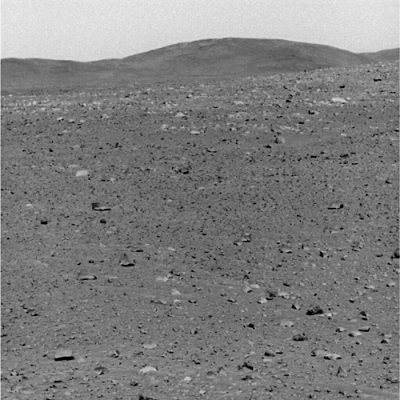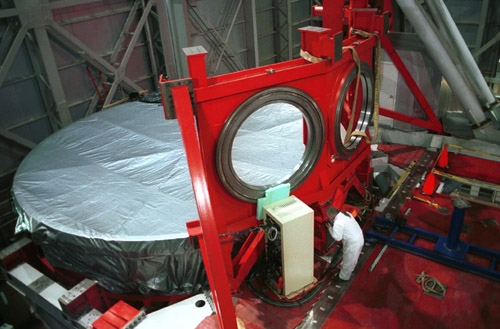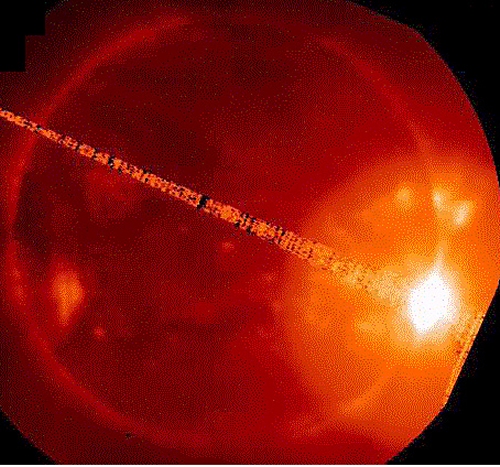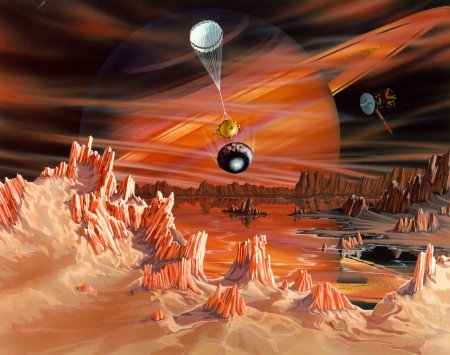Key Takeaways:
Four ways to see Saturn
A montage of recent Cassini images shows there is more to the ringed planet than meets the eye. The pictures, taken of the same face of Saturn in four different regions of the spectrum, show the effects of absorption and scattering of light by atmospheric gas and clouds.
A sliver of light in the northern hemisphere that appears bright in the ultraviolet and blue is nearly invisible at longer wavelengths. The clouds in this part of the northern hemisphere are deep, and sunlight is illuminating only the cloud-free upper atmosphere. The shorter wavelengths are consequently scattered by the gas, which makes the illuminated atmosphere bright, while the longer wavelengths are absorbed by methane.
Saturn’s rings also appear noticeably different from image to image, whose exposure times range from 2 to 46 seconds. The rings appear dark in the 46-second ultraviolet image because they inherently reflect little light at these wavelengths. The differences seen at other wavelengths are mostly due to differences in exposure times.
— Pamela Zerbinos
Iapetus mystery slightly less mysterious
As the strange moon Iapetus orbits Saturn, its dark side is always in front. This “leading” hemisphere appears black, while the “trailing” hemisphere is ten times brighter. A team of astronomers, writing in this week’s Science, think they may have figured out why.
The astronomers used the radar system at the Arecibo Observatory in Puerto Rico to scan the moon. Their findings suggest the dark material on the leading face is a thin coating — only a few centimeters thick — of dust or organic material. This coating probably was shed by nearby saturnian moons.
They also presented that Iapetus possibly has a layer of ammonia-rich material under a thin coat of ice. Ammonia may have been an important material during the formation of Saturn and its moons. — Pamela Zerbinos
Greater sensitivity at Arecibo
A new attachment to the Arecibo Observatory telescope has improved what is already the world’s most sensitive single dish radio telescope. The size of a washing machine, the Arecibo L-Band Feed Array (ALFA) will perform large-scale sky surveys with exceptional sensitivity, allowing astronomers to gather data about seven times faster than at present.
Typically, radio telescopes have been limited to observing a single pixel of territory at once. ALFA’s ability to see seven spots — seven pixels — at once, however, dramatically reduces the time necessary to exercise large-scale sky surveys. — Jeremy McGovern
Gravity Probe-B launched
Aboard a Boeing Delta II expendable launch vehicle, NASA’s Gravity Probe-B (GP-B) was successfully launched from Vandenberg Air Force Base in southern California. The spacecraft will test two important predictions of Albert Einstein’s theory of general relativity.
Einstein’s theory holds that space and time are distorted by the presence of huge objects. GP-B, using four ultra-precise gyroscopes, will measure how space and time are somewhat warped by Earth’s presence and how Earth’s rotation slightly drags both around with it.
This mission will finish sometime in 2005, followed by a year of analysis by project scientists. — Jeremy McGovern
Mars Exploration Rover updates
One hundred sols already? Spirit celebrated its 100th sol on the Red Planet continuing to drive toward its target, the Columbia Hills. So far, the rover has traveled 0.44 miles (706.5 meters) on the martian surface.
On sol 78, Opportunity woke up after a 4-sol lull to install a flight-software update-package that included three key changes. (Spirit received two of these upgrades on its sol 98.)
First, the rovers received an update to the autonomous-navigation software that allows the rovers to turn in place to find the best route, enabling them to travel long distances autonomously.
The second update helps the rovers recover more easily from an irregularity like the one that occurred on Spirit’s sol 18.
Specific to Opportunity, the third update guards against energy loss associated with the stuck heater on the rover’s instrument-deployment device. The fix allows project scientists to set the rover in a deep-sleep mode, where its batteries are completely unable to power the stuck switch. Rover controllers will not initiate the deep-sleep capability on Spirit unless it becomes necessary.
On sol 80, Opportunity went on to dig in a trench, obtaining close-up views of targets called “Jeff’s Choice,” “RipX,” “Jack Russell,” “Beagle Burrow,” and “NewRipX.”
— Jeremy McGovern
Microlensing reveals a planet
Astronomers looking for a transitory change in the brightness of a distant star have found a planet using microlensing. The planet orbits a red dwarf star in the constellation Sagittarius; as the star and planet drifted in front of another star lying 24,000 light-years from Earth, their combined gravity acted as a lens to magnify briefly the remote star’s light.
Because the star and planet both exerted a gravitational effect, the brightness change was not a simple pulse and required careful analysis. Study revealed the existence of the planet and showed it has about 1.5 times the mass of Jupiter and orbits at 3 times the Earth-Sun distance from its star.
Microlensing can help astronomers detect low-mass planets, but it means they have to keep millions of stars under watch at once. — Robert Burnham
27-foot mirror installed in LBT
The first 27-foot (8.4-meter) primary mirror for the world’s most powerful telescope, the Large Binocular Telescope (LBT), has successfully been installed in the telescope structure at the University of Arizona’s Mount Graham International Observatory.
The 18-ton parabolic mirror was cast and figured at Arizona’s Steward Observatory Mirror Lab and is the first of two identical giant mirrors that will make up the LBT. Each mirror is a honeycomb structure made out of borosilicate glass that was melted, molded, and spun into shape in a specially designed rotating oven. Once cast, the mirror was polished to near-perfection, to within a millionth of an inch of the desired shape over its entire surface.
The Mirror Lab currently is polishing the second mirror, and first light is expected later this year. Once operational, the LBT will be the world’s most technologically advanced optical telescope and is expected to create images nearly ten times sharper than the Hubble Space Telescope. — Pamela Zerbinos
Caught in the act
The Cassini spacecraft caught two saturnian storms in the act of merging into one. Storm merging is a distinct feature of the gas giants and has been observed only once before on the ringed planet.
“On Earth, storms last for a week or so and usually fade away,” says Andrew Ingersoll, a member of the Cassini imaging team. “On Saturn and the other giant planets, storms last for months, years, or even centuries.”
The storms, each around 600 miles (965 kilometers) in diameter, were seen moving west relative to Saturn’s rotation for about a month before they merged on March 19-20. They approached one another at speeds up to 25 miles (40 kilometers) per hour and then began to swirl in a counterclockwise direction as they merged.
“Instead of simply fading away, many storms on the giant planets end their lives by merging. How they form, however, is still uncertain,” explains Ingersoll.
Just after the merger, the new storm was elongated north-south with bright clouds on either end. Two days later, the storm settled into a more circular shape and the bright clouds spread around the storm’s circumference to form a halo.
— Pamela Zerbinos
NASA prolongs MER mission
NASA has approved an extended mission for the Spirit and Opportunity rovers, giving them up to five months of additional assignments on Mars as their primary, three-month mission comes to a close.
The mission extension provides $15 million to operate the rovers through September, more than doubling their exploration time. Seven new goals have been set to extend the science and engineering accomplishments of the prime mission.
The new science objectives are for Spirit to reach Columbia Hills — which could hold further geological clues about the former shallow body of salt water discovered in Meridiani Planum – and for Opportunity to reach outcrops in Endurance Crater; to continue atmospheric studies to encompass more of Mars’s seasonal cycle; and to calibrate and validate data from Mars orbiters for additional types of rocks and soils examined on the ground.
The three new engineering goals are to traverse more than a kilometer; to characterize solar-array performance over a long duration of dust deposition at both landing sites; and to demonstrate long-term operation of two mobile science robots on a distant planet. — Pamela Zerbinos
Scramjet flight successful
Following an initial data review, a recent NASA X-43A hypersonic research aircraft flight was determined a success. On March 27, a B-52B took the X-43A over the test range off the California coast. A modified Pegasus rocket boosted the experimental aircraft to its test altitude of nearly 95,000 feet (29,000 meters). The X-43A separated from the booster and flew freely under its own power until eventually landing in the Pacific Ocean.
“The data clearly shows, and without question, that scramjets work,” says X-43A chief engineer Griff Corpening of NASA’s Dryden Flight Research Center in Edwards, California. “But we did see a couple of areas that differed from what was seen in the wind tunnels, thus reinforcing the need for flight testing.”
The flight set a new aeronautical speed record — approximately 5,000 miles (8,050 kilometers) per hour. This is the fastest any known aircraft powered by an air-breathing engine has ever flown. — Jeremy McGovern
Star production peaked 5 billion years ago
The universe reached its peak star-producing power 5 billion years ago — more recently than previously thought — according to a team of researchers from the University of Pennsylvania and the University of Edinburgh.
The team of astronomers sifted through data collected by the Sloan Digital Sky Survey from 96,545 nearby galaxies to chronicle the complete history of star formation over time. By the time our Sun was born, about 4.7 billion years ago, almost half the stellar mass in the universe already had been created. Star formation has dropped off drastically since then and, because old stars are dying faster than new stars are being born, the universe gradually will become a much dimmer place.
The findings, published in the April 8 issue of the journal Nature, also show a difference in star formation between low-mass and high-mass galaxies. Galaxies with a higher mass, our own Milky Way among them, formed most of their stars well before galaxies of a lower mass did. Researchers say this explains why previous studies showed a much earlier date of star formation, as those studies were able to examine only the more massive galaxies. — Pamela Zerbinos
Genesis secures solar-wind payload
Since October 2001, NASA’s Genesis spacecraft has gathered particles from the solar wind. Recently, the Genesis team deactivated the collectors and stowed the samples. With the payload capsule targeted to return to Earth on September 8, 2004, NASA will prepare for its first sample return from space since Apollo 17 in December 1972. To collect the particles, Genesis used arrays of sapphire, silicon, gold, and diamond.
“The material our collector arrays are made of may sound exotic, but what is really unique about Genesis is what we collected on them,” explains the mission’s principal investigator, Don Burnett. “With data from this mission, we should be able to say what the Sun is composed of at a level of precision for planetary science purposes that has never been seen before.”
Later this month, Genesis will begin trajectory maneuvers that will place the spacecraft on a route toward Earth. The capsule will re-enter Earth’s atmosphere for a planned landing at the United States Air Force Utah Test and Training Range. — Jeremy McGovern
Antifreeze comet
Jacques Crovisier (Paris Observatory) and his team report the discovery of ethylene glycol in archived radio spectra of Comet Hale-Bopp (C/1995 O1). The ten-atom molecule, HOCH2CH2OH, which is used as antifreeze in cooling fluids for automobiles, “is the most complex chemical species ever identified in a comet by means of spectroscopy,” say the scientists. Hale-Bopp, an unusually active comet, produced 1031 water molecules — enough to fill a couple of Olympic-size swimming pools — each second when it passed through perihelion in early April 1997. In terms of the relative number of molecules formed, Hale-Bopp produced 0.25 percent as much ethylene glycol as it did water.
So what’s antifreeze doing in a comet? Ethylene glycol is the chemically reduced form of the simplest sugar (glycolaldehyde) and has been found in interstellar clouds (such as Sagittarius B2) and meteorites (like the Murchison and Murray carbonaceous chondrites). Its discovery in Comet Hale-Bopp “makes it even more compelling that volatile cometary matter retains a significant interstellar signature,” the team writes, saying that it strengthens the connection between cometary and interstellar material. Their work appeared in the March 18, 2004, issue of Astronomy & Astrophysics. — Francis Reddy
A bigger, badder solar flare
On November 4, 2003, the largest flare ever recorded erupted on the Sun. The barrage of X rays quickly rose to a level of X 17.4, which overwhelmed X-ray detectors aboard the Geostationary Operational Environmental Satellites (GOES). The detectors remained that way for 13 minutes, until the burst of radiation faded enough that it no longer saturated the instruments. Although the flare’s X-ray peak could not be measured directly, scientists at the National Oceanic and Atmospheric Administration’s Space Environment Center later extrapolated existing data to peg the flare at X 28 on their intensity scale — the biggest event recorded in nearly thirty years of satellite observations.
Now, Neil Thomson, Craig Rodger, and Richard Dowden of the University of Otago in Dunedin, New Zealand, offer an estimate of the flare’s peak based on how Earth’s ionosphere responded to the flood of radiation. During the day, ultraviolet light from the Sun breaks up nitric oxide, a minor atmospheric constituent, to form the lowest portion of the ionosphere, called the D region. But X rays from solar flares are potent enough to break up the dominant gases there — molecular nitrogen and oxygen. This lowers the height at which radio waves bounce off the D region and alters the signals in a manner that depends on the intensity of the X-ray flux.
The researchers examined the “phase shift” of signals from Very Long Frequency radio transmitters operated by the U.S. Navy in Washington, Hawaii, and North Dakota at the time of the big event. They conclude the flare peaked at X 45, or more than twice the intensity of any other solar flare since satellite observations began in the mid-1970s. They published their work in the March 17, 2004, issue of Geophysical Research Letters.
— Francis Reddy
Titan I: the Crab Nebula transit
Titan is the only satellite in the solar system with a thick atmosphere, a fact even more impressive when one realizes that its surface pressure exceeds by half that at Earth’s sea level. It also extends much farther into space than Earth’s owing to Titan’s weaker gravity. While its atmospheric structure has been studied by spacecraft and probed in radio, infrared, optical, and ultraviolet wavelengths, scientists lacked direct information on its structure between an altitude of 500 and 1,000 kilometers (310 and 620 miles).
So when Saturn and its moons slipped across the Crab Nebula on January 5, 2003, astronomers monitored the event with the Chandra X-ray Observatory. The Saturn transit itself could not be observed because Chandra was passing through a zone of elevated radiation during the event, but a group led by Koji Mori of Pennsylvania State University did catch Titan’s passage. The moon cast a detectable shadow as it moved over the 2′-wide X-ray-bright portion of the Crab Nebula, the remnant of the A.D. 1054 supernova blast. Mori’s analysis found the shadow to be larger than Titan’s solid surface, yielding the first-ever measurement of the moon’s atmospheric extent in X rays: 880 km (547 miles). The work will appear in a forthcoming issue of The Astrophysical Journal.
The saturnian system has a conjunction with the Crab every thirty years, but transits are exceedingly rare. A conjunction similar to the 2003 event occurred in January 1296, but the remnant, which was only two-and-a-half centuries old then, was probably so small that a transit never happened. The next transit takes place in August 2267.
The Huygens probe aboard the Cassini spacecraft will study Titan’s atmosphere directly in 2005. — Francis Reddy
Last year, a group using the radio telescope at Arecibo Observatory in Puerto Rico announced that Titan’s surface reflected radio waves in a manner suggestive of a mirror-like surface. The radar glints suggested that liquids comprise most of Titan’s surface, which is consistent with the decades-old speculation of hydrocarbon seas there.
A team led by planetary scientists Nadeem Ghafoor (Surrey Satellite Technology) and John Zarnecki (Open University) adapted a computer model describing wind-driven waves on Earth to conditions on Titan, including its lower gravity — just 15 percent of Earth’s — and the surface tension and viscosity of seas composed of 70 percent ethane, 25 percent methane, and 5 percent nitrogen. A breeze of 12 miles (20 kilometers) per hour generated waves 16 feet (5 meters) high — seven times higher than it would on Earth. But in Titan’s cold, sludge-coated seas, waves would be widely separated and travel more slowly than in terrestrial oceans.
The European Space Agency’s Huygens probe, now en route aboard the Cassini spacecraft, “might become the first extraterrestrial boat if it does indeed land on a hydrocarbon lake or sea,” says Gafoor.
Trying to picture the scene, Zarnecki says, “the surface around us would probably appear flat and deceptively calm, but in the distance, we might see a rather tall, slow-moving wave advancing toward us.”
The group presented their findings at the Royal Astronomical Society National Astronomy Meeting in Milton Keynes, England, on Wednesday, March 31. — Francis Reddy

